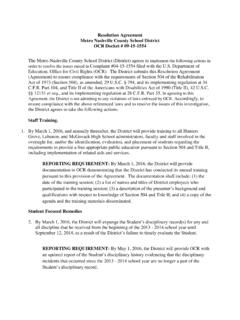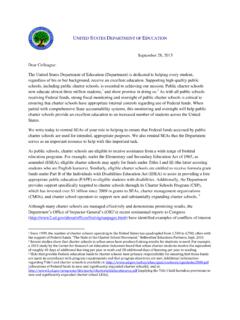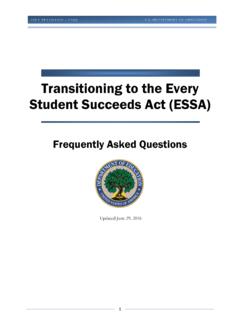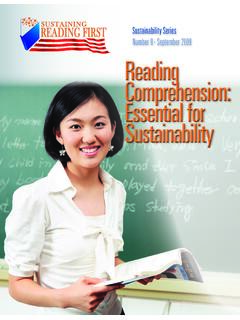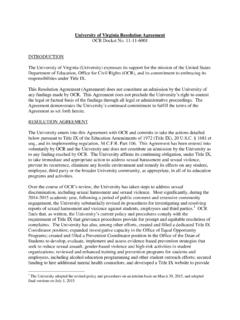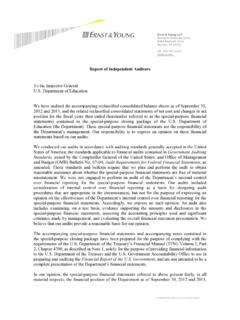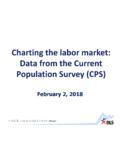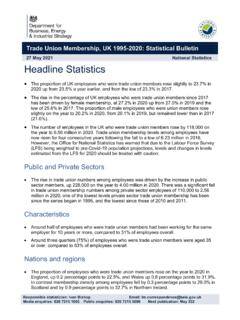Transcription of The State of Racial Diversity in the Educator Workforce
1 THE State OF Racial DIVERSITYIN THE Educator WORKFORCE2016 iTHE State OF Racial Diversity IN THE Educator WORKFORCEJULY 2016 POLICY AND PROGRAM STUDIES SERVICEOFFICE OF PLANNING, EVALUATION AND POLICY DEPARTMENT OF EDUCATION Department of EducationJohn B. King, Jr. SecretaryOffice of Planning, Evaluation and Policy Development Amy McIntosh Delegated Duties of Assistant Secretary Policy and Program Studies Service Jennifer Bell-Ellwanger DirectorJuly 2016 This report is in the public domain. Authorization to reproduce it in whole or in part is granted. While permission to reprint this publication is not necessary, the citation should be Department of Education, Office of Planning, Evaluation and Policy Development, Policy and Program Studies Service, The State of Racial Diversity in the Educator Workforce , Washington, 2016.
2 This report is available on the Department s website at of Alternate FormatsRequests for documents in alternate formats such as Braille or large print should be submitted to the Alternate Format Center by calling 202-260-0852, or by contacting the 504 coordinator via e-mail at to Limited English Proficient PersonsIf you have difficulty understanding English you may request language assistance services for Department information that is available to the public. These services are available free of charge. If you need more information about interpretation or translation services, please call 1-800-USA-LEARN (1-800-872-5327) (TTY: 1-800-437-0833), or e-mail us at Or write to Department of Education, Information Resource Center, LBJ Education Building, 400 Maryland Ave. SW, Washington, DC 20202. iiiCONTENTSList of Figures ..ivIntroduction ..1 Summary of Findings.
3 3 Racial Diversity of Students and Educators ..5 Racial Diversity of Students ..5 Racial Diversity of Teachers ..6 Racial Diversity of Principals.. 7 Educator Pipeline.. 9 Postsecondary Enrollment.. 10 Teacher Preparation Programs.. 13 Enrollment at Historically Black Colleges and Universities (HBCUs).. 16 Alternative-Route Teacher Preparation Program Students ..17 Postsecondary Completion ..18 Entering the Teacher Workforce ..22 Bachelor s Degree Graduates.. 22 New Teachers ..25 Teacher Workforce ..27 Teacher Retention ..29 Conclusion ..31 Endnotes.. 33ivFIGURES Figure 1. Percentage distribution of students enrolled in public elementary and secondary schools, by race/ethnicity: Fall 2002, fall 2012, and fall 2024 ..5 Figure 2. Percentage distribution of teachers in public elementary and secondary schools, by race/ethnicity: Selected years, 1987 88 through 2011 12.
4 6 Figure 3. Percentage distribution of public school principals, by race/ethnicity: Selected years 2003 04, 2007 08, and 2011 12.. 8 Figure 4. Key points along the Educator pipeline ..9 Figure 5. Percentage of enrollment for high school graduates and bachelor s degree students, by race/ethnicity: 2011 12.. 10 Figure 6. Percentage distribution for bachelor s degree students, by major and race/ethicnicity: 1999 2000 and 2011 12.. 11 Figure 7. Percentage distribution of master s degree students, by field of study and race/ethnicity: 1999 2000 and 2011 12.. 12 Figure 8. Percentage of bachelor s degree students majoring in education, by race/ethnicity: 2011 12 ..12 Figure 9. Percentage of master s degree students enrolled in an education-related field of study, by race/ethnicity: 2011 12.. 13 Figure 10. Black enrollment in teacher preparation programs, by State where program is located: 2013 14.
5 14 Figure 11. Hispanic enrollment in teacher preparation programs, by State where program is located: 2013 14 ..14 Figure 12. Percentage distribution of all enrollees in IHEs with teacher preparation programs versus the distribution of enrollees at those IHEs who are in a teacher preparation program, by race/ethnicity: 2012 13.. 15 Figure 13. Share of teacher preparation program enrollment in HBCUs: 2012 13.. 17 Figure 14. Percentage distribution for types of teacher preparation programs, by race/ethnicity: 2012 13.. 18 Figure 15. Cumulative persistence and attainment by 2008 09 for bachelor s degree students who began postsecondary education in 2003 04, by major and race/ethnicity.. 19vFigure 16. Share of awards conferred for education majors and all majors, by institution type: 2012 13.
6 20 Figure 17. Share of education major awards conferred, by MSI/HBCU status: 2012 13 ..21 Figure 18. Percentage of education degrees awarded to white students compared to percentage of non-education degrees awarded to white students, by institution type: 2012 13 ..22 Figure 19. Percentage distribution of 2007 08 bachelor s degree recipients who reported applying for k 12 teaching position as of 2012, by race/ethnicity.. 23 Figure 20. Percentage of 2007 08 bachelor s degree recipients who reported applying for a k 12 teaching position as of 2012, by race/ethnicity.. 24 Figure 21. Percentage distribution of 2007 08 bachelor s degree recipients for all majors, for those who majored in education, and for those who worked as a k 12 teacher, by race/ethnicity: 2012.
7 25 Figure 22. Percentage distribution of public school teachers for all teachers and teachers with three or fewer years of experience, by race/ethnicity: 2012 ..26 Figure 23. Percentage distribution of classroom teachers in geographic categories of districts, by race/ethnicity: 2014 ..27 Figure 24. Percentage distribution of new classroom teachers in geographic categories of districts, by race/ethnicity: 2014 ..28 Figure 25. Percentage distribution of principals in geographic categories of districts, by race/ethnicity: 2014 ..28 Figure 26. Percentage distribution of new principals, by race and social conditions of districts: 2014.. 29 Figure 27. Percentage of public school teachers who remained in the same school, by race/ethnicity: School years 2011 12 to 2012 13 ..301 INTRODUCTION Without question, when the majority of students in public schools are students of color and only 18 percent of our teachers are teachers of color, we have an urgent need to act.
8 We ve got to understand that all students benefit from teacher Diversity . We have strong evidence that students of color benefit from having teachers and leaders who look like them as role models and also benefit from the classroom dynamics that Diversity creates. But it is also important for our white students to see teachers of color in leadership roles in their classrooms and communities. The question for the nation is how do we address this quickly and thoughtfully? Education Secretary John B. King, Jr., Speaking at Howard University, March 8, 2016. The Department of Education is dedicated to increasing the Diversity of our Educator Workforce , recognizing that teachers and leaders of color will play a critical role in ensuring equity in our education system. The release of this data is consistent with the Department s mission and values, and is intended to provide a basis for discussion, strategy development, and further research.
9 Diversity is inherently valuable. We are stronger as a nation when people of varied backgrounds, experiences, and perspectives work and learn together; Diversity and inclusion breed innovation. Groups of more diverse problem solvers have been found to outperform groups of less diverse problem solvers,1 and companies with more Diversity in their leadership also tend to be top financial Research shows that Diversity in schools, including Racial Diversity among teachers, can provide significant benefits to students. While students of color are expected to make up 56 percent of the student population by 2024, the elementary and secondary Educator Workforce is still overwhelmingly In fact, the most recent Department of Education Schools and Staffing Survey (SASS), a nationally representative survey of teachers and principals, showed that 82 percent of public school teachers identified as white. This figure has hardly changed in more than 15 years; data from a similar survey conducted by the Department in 2000 found that 84 percent of teachers identified as Improving teacher Diversity can help all students.
10 Teachers of color5 are positive role models for all students in breaking down negative stereotypes and preparing students to live and work in a multiracial society. A more diverse teacher Workforce can also supplement training in the culturally sensitive teaching practices most effective with today s student populations. 2In addition to providing social advantages for all students, the Racial Diversity of the teaching Workforce can help to close the achievement gap,6 emerging research7 suggests. Both quantitative and qualitative studies find that teachers of color can improve the school experiences of all students; further, teachers of color8 contribute to improved academic outcomes while serving as strong role models for One report suggests that, compared with their peers, teachers of color are more likely to (1) have higher expectations of students of color (as measured by higher numbers of referrals to gifted programs);10 (2) confront issues of racism; (3) serve as advocates and cultural brokers; and (4) develop more trusting relationships with students, particularly those with whom they share a cultural A recent report shows that, despite the critical role that teachers of color can play in helping students of color succeed, every State has a higher percentage of students of color than teachers of The teaching force has become slightly more diverse in recent years.
